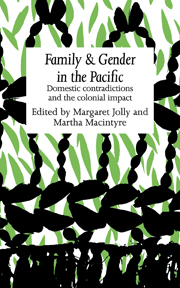Book contents
- Frontmatter
- Contents
- List of contributors
- Acknowledgements
- Map of main island groups of the Pacific
- Map of Papua New Guinea – Provinces
- Introduction
- 1 New England missionary wives, Hawaiian women and ‘The Cult of True Womanhood’
- 2 Changes in the lives of ordinary women in early post-contact Hawaii
- 3 Domestic structures and polyandry in the Marquesas Islands
- 4 The object lesson of a civilised, Christian home
- 5 Medical care and gender in Papua New Guinea
- 6 Suffer the children: Wesleyans in the D'Entrecasteaux
- 7 Women in contemporary Central Enga society, Papua New Guinea
- 8 Better homes and gardens
- 9 God, ghosts and people: Christianity and social organisation among Takuru Wiru
- 10 Sins of a mission: Christian life as Kwaio traditionalist ideology
- 11 Sacred spaces: churches, men's houses and households in South Pentecost, Vanuatu
- 12 Bond-slaves of Satan: Aboriginal women and the missionary dilemma
- Bibliography
- Index
3 - Domestic structures and polyandry in the Marquesas Islands
Published online by Cambridge University Press: 05 November 2011
- Frontmatter
- Contents
- List of contributors
- Acknowledgements
- Map of main island groups of the Pacific
- Map of Papua New Guinea – Provinces
- Introduction
- 1 New England missionary wives, Hawaiian women and ‘The Cult of True Womanhood’
- 2 Changes in the lives of ordinary women in early post-contact Hawaii
- 3 Domestic structures and polyandry in the Marquesas Islands
- 4 The object lesson of a civilised, Christian home
- 5 Medical care and gender in Papua New Guinea
- 6 Suffer the children: Wesleyans in the D'Entrecasteaux
- 7 Women in contemporary Central Enga society, Papua New Guinea
- 8 Better homes and gardens
- 9 God, ghosts and people: Christianity and social organisation among Takuru Wiru
- 10 Sins of a mission: Christian life as Kwaio traditionalist ideology
- 11 Sacred spaces: churches, men's houses and households in South Pentecost, Vanuatu
- 12 Bond-slaves of Satan: Aboriginal women and the missionary dilemma
- Bibliography
- Index
Summary
Since the importance of feminist theory was recognised by some of those engaged in social and historical analysis a number of questions concerning the connections between social relations based upon gender and those based upon other factors such as rank or economic relations have been discussed extensively in history, anthropology and some other fields. In particular there have been attempts to better understand domestic groups and the ways in which labour within such groups relates to larger socialised labour processes and contributes to whole economies, and how, in a more simple sense, hierarchies which use sex as a means for social differentiation articulate with other hierarchies. This chapter aims to pursue some of these questions in a particular context, in part by focussing on one famous, or notorious, Marquesan institution.
A certain constellation of practices existed in that part of eastern Polynesia which various Western writers have called polyandry. What they were talking about was a situation whereby some women had a primary husband and, in addition, one or more secondary husbands, who were to some extent domestic servants. In some cases, mostly noted after many decades of destructive contact, the polyandrous husbands were brothers (Chaulet 1873: 74; Utley 1938: 232), but this was far from usual; the Marquesan system was thus significantly different from the fraternal polyandry which existed widely in the Himalayas and in other areas in Asia (Majumdar 1962:V).
- Type
- Chapter
- Information
- Family and Gender in the PacificDomestic Contradictions and the Colonial Impact, pp. 65 - 83Publisher: Cambridge University PressPrint publication year: 1989
- 1
- Cited by



